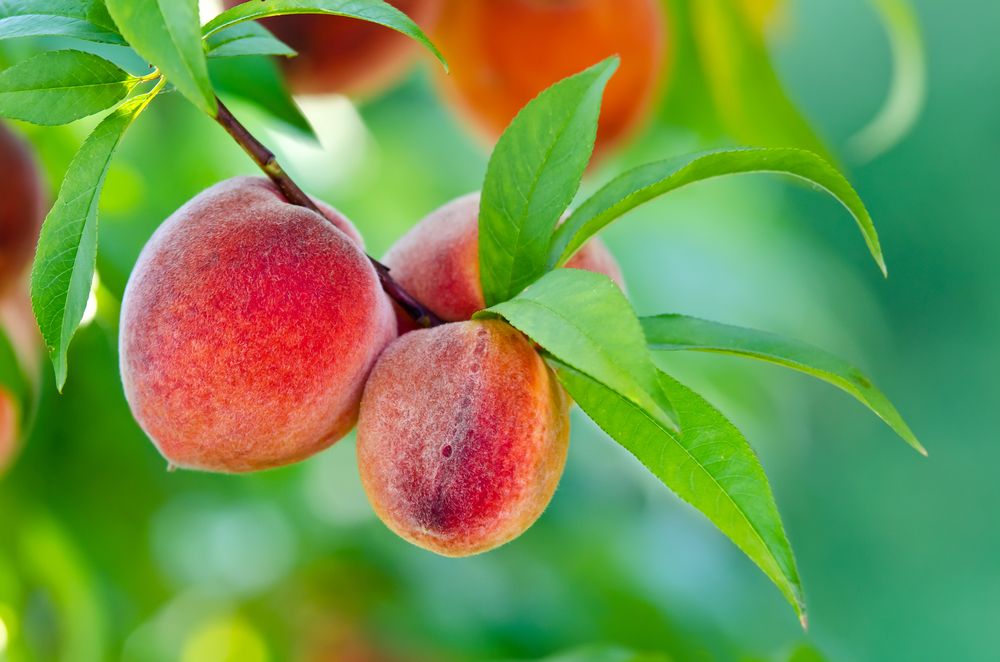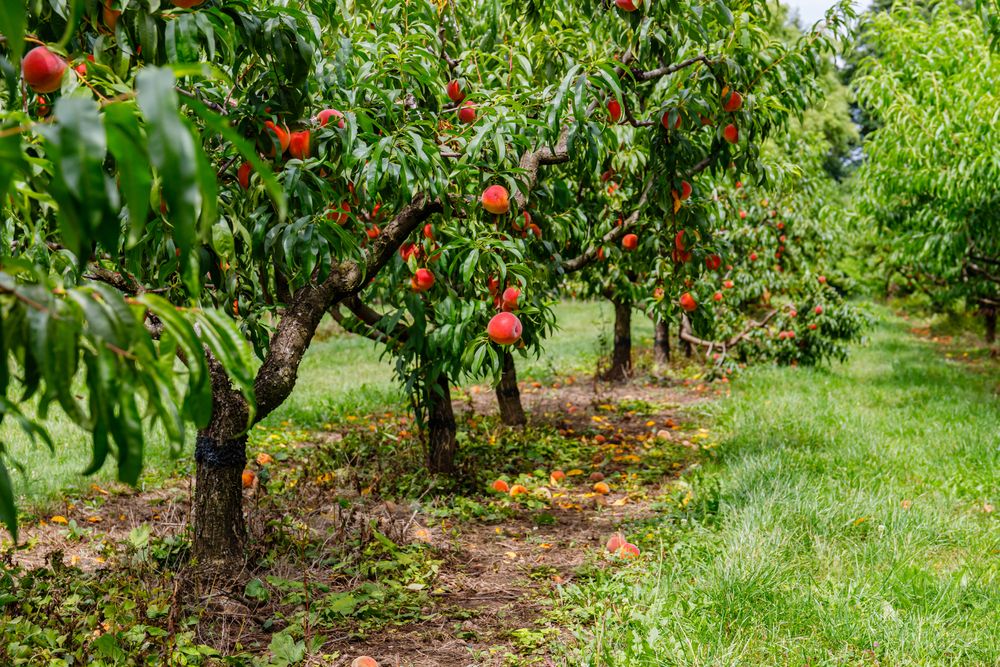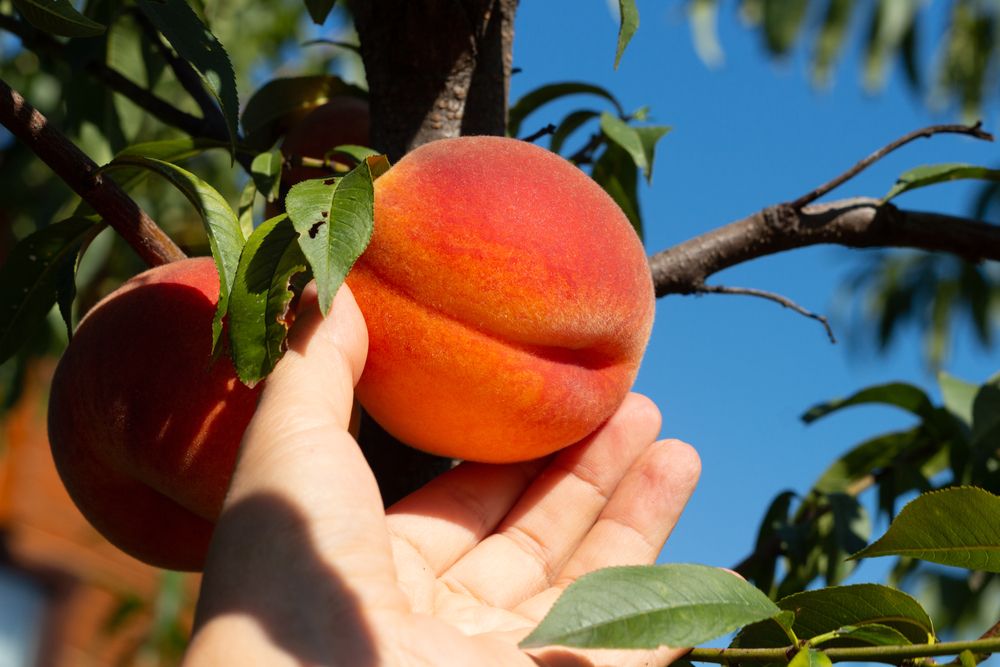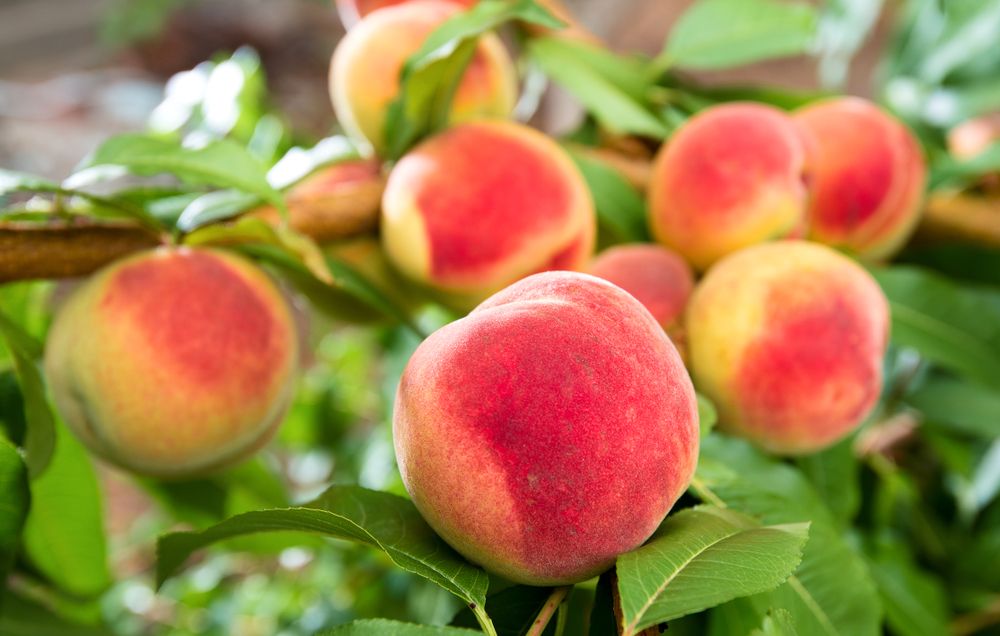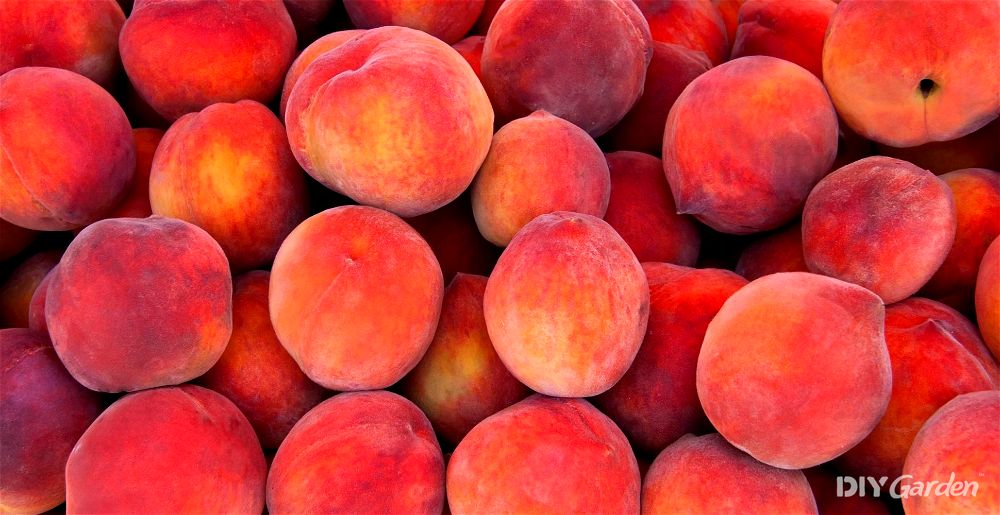
Nothing quite beats the sugary sweet flavour, succulent texture, and thirst-quenching juiciness of a perfectly ripened, sun-warmed peach – something that you can only truly appreciate by growing your own. Fortunately, this is easier than many would imagine. Peaches may look and taste quite exotic, but selective breeding over the years means that there are now peach tree varieties available that are capable of growing in a wide range of climates, making this juicy fruit more accessible than ever.
Growing Peaches: A Quick Snapshot
When to Sow – Oct-Feb
When to Plant – Nov-Jun
When to Harvest – Jun-Sep
Average Yield per Plant – 40-80kg/year (once mature)
Spacing – 5-6m
Depth – 2.5cm
How to Grow Peaches at Home
Many don’t realise that peaches originate from China, where they’re found growing wild all the way from the cold regions of the north to the humid, subtropical areas of the south. This means that the trees are actually pretty adaptable – meet their basic requirements and they should turn into a highly productive addition to your garden.
Growing Requirements for Peach Trees
Let’s start with temperature, since this is where many gardeners struggle. Although they’re technically one of the least hardy of all of the stone fruits out there, the fact that they go dormant in the winter enables most peach varieties to withstand freezing temperatures down to -10ºC, with some varieties being even hardier than this. In fact, they need a chilling period each year to produce new buds the following season.
However, winter temperatures aren’t the biggest problem for most gardeners. Instead, since peach trees flower quite early in the year, usually from February to April, spring frosts can quickly decimate peach blossoms, leaving you with no fruit. So, for those of you in colder climates, early spring protection is more important than protecting your tree over the winter while it’s dormant.
In terms of sun, peach trees need plenty of it. Full sun is best – anything less than 6-8 hours of full sunlight a day will inhibit fruit production and quality. Many choose to plant their peach trees near sunny walls, as this also offers some wind protection and a warmer microclimate, but make sure that your trees don’t end up shaded by the wall during the day.
Peach trees aren’t too fussy when it comes to soil. They’ll do well in a variety of soil types, so long as it is well-draining. This means that heavy clay soil will need to be amended before planting a peach tree.
How to Grow Peaches from Seed
It usually takes a few years for a peach tree grown from seed to produce fruit, which is why many tend to start with young trees instead – you won’t have to wait quite so long for your first harvest. However, peach trees aren’t cheap, and chances are that most nurseries won’t stock a wide range of varieties, meaning that you could end up choosing something that isn’t well-suited to your garden.
If your growing conditions are less-than-ideal in any way, meaning a special variety is required, or you’re looking for multiple peach trees, then starting them from seed is the way to go. However, before you can get sowing, you’ll need to first stratify your peach seeds to kickstart the germination process. If you don’t, you’ll end up waiting for several months before seedlings start to emerge.
How to Stratify Peach Seeds
Before stratifying your peach seeds, you may want to consider cleaning them. Since peach trees need to be stratified for four months (the longest out of all stone fruit seeds), they can easily succumb to mildew during this time. Scrubbing the pit with a dry toothbrush and then applying a fungicide to the seed can help to prevent this. However, this only really applies to seeds that you’ve saved yourself – if you’ve purchased your peach seeds, then chances are that they have already been cleaned and treated.
To stratify your peach seeds, follow these steps:
- If you plan on planting fresh peach pits, crack them open and remove the kernels from within. This will significantly speed up germination time
- Place your seeds into a sealed plastic bag with some moist potting soil
- Place the bag into your fridge for 3-4 months
- Once your seeds have grown roots that are 1-2cm long, remove the bag from the fridge
How to Sow Peach Seeds
- Fill tall pots (at least 30cm deep) with multi-purpose compost. Peach saplings have very long tap roots, so your pots need to be able to accommodate this
- Water the pots well to make sure that the compost is damp and that the drainage holes in your pots aren’t blocked
- Sow one peach seed in each pot, about 2.5cm deep
- Place your pots somewhere warm and keep them moist
The germination time for peach seeds varies – it could take anywhere from two weeks to a few months before you notice signs of life. However, once you do, move your pots somewhere sunny, so that your seedlings are receiving plenty of light.
How to Plant Peach Trees Outside
While bare-root peach trees that you’ve purchased can be planted outside in the middle of winter (it’s best to plant them while they’re dormant), saplings that you have started from seed are much more delicate. You’ll need to wait until you’ve had your last spring frost before planting your saplings out. You should also make sure that each one has at least two sets of true leaves.
Peach trees that you’ve purchased that have already been growing outside can be planted straight away. However, if your peach saplings have been inside all winter, you’ll need to harden them off first. Do this over ten days or so – don’t rush the process, as you don’t want your peach trees to end up dying from transplant shock after all the work that you’ve put in so far!
Then, amend your soil if necessary, before digging a hole for each of your peach trees. The holes should be just slightly deeper than the root ball of each sapling, but double the width. Space each hole 5-6m apart, depending on the variety that you’re growing.
Place a sapling into each hole and then backfill the hole with soil. Firm the soil down around each tree to prevent the trees from rocking in the wind, before watering deeply.
Do Peach Trees Need to Be Staked?
If you’re planting a large, mature peach tree, then it would be best to give it a stake. However, if you’re planting a younger tree, then a stronger root system will be established if you don’t use a stake.
How to Plant Peach Trees in a Greenhouse
Since peach trees love the heat, they usually do very well in a greenhouse. Give them a bed that’s as deep as possible – 45-60cm is a minimum.
Since peach trees can grow to over 7m in height, you’ll need to pick a variety that’s suitable for greenhouse growing. Most gardeners choose dwarf varieties, which also means that less space will be needed in terms of width too.
If space is really tight, then another option would be to grow your peach trees in containers. This way, you’ll be able to bring them into your greenhouse in the winter, before moving them back outside after your last frost, making room for all of your other spring and summer crops. So long as you pick a suitable variety and use a large enough container, peach trees grown in pots can be highly productive.
How to Care for Peach Trees
While peach trees may be a little needier than some of the other fruit trees out there, their delicious and abundant yields make them well worth the extra attention they require.
Watering Peach Trees
Peach trees require the most water the first couple of years after planting – this is what helps them to establish a strong root system. So, during this time, make sure that they’re receiving about 2.5cm of water a week. After they’ve matured, that same 2.5cm of water will last a peach tree for about 10-14 days.
Feeding Peach Trees
The nutrients that your peach trees need will depend on their age. While young, phosphorus is key – this helps with root development. A balanced, general-purpose fertiliser will provide this, and should be used until a peach tree is three years old.
After this, nitrogen and potassium become more important, so choose a fertiliser that contains higher levels of those two nutrients.
The best time to fertilise a peach tree is in late winter/early spring, just before the tree starts to show signs of new growth for the year. Try to keep the fertiliser about 45cm away from the trunk – this will encourage the tree to send its roots outwards.
Weeding and Mulching Peach Trees
Weeds can significantly affect yield, so it’s best to keep your peach trees as weed-free as possible. One way to cut back on the amount of time you spend weeding is to lay an organic mulch around each tree. Not only will this suppress weeds, but it’ll also provide a slow and steady source of moisture and nutrients to your trees.
Pruning Peach Trees
If you want your yields to increase each year, then your peach tree will need to be annually pruned. Failing to do this will weaken the tree, lowering production.
While it’s important to read up on peach tree pruning from a few different sources before you get started, your general aim should be to maintain an open centre. Do this in the spring, just after the tree has started growing for the year.
How to Harvest Peaches
Harvest time will vary depending on the varieties that you’re growing. Early varieties grown in a greenhouse could be ready for picking as early as June, whereas late-flowering varieties growing outside may only ripen in September.
Either way, you’ll know that a peach is ripe by its colour – once there’s no sign of green anywhere on its skin, then it’s ready to be picked. You’ll also notice that the flesh of the fruit around the stalk feels soft. Peaches tend to ripen at the same time, so pick one to begin with and give it a taste before harvesting the rest.
Harvesting a peach is easy. Cup the fruit in the palm of your hand and gently lift it upwards while twisting it slightly, and it should come away from the tree. Be gentle when picking peaches – they bruise easily!
How to Store Peaches
Fresh peaches can be stored in the fridge for about five days, but should be kept in a plastic bag.
However, since a mature tree can produce up to 80kg of peaches in one season, you’ll need to have some long-term storage options up your sleeve. Freezing and canning are popular methods, or you could also whip up batches of peach jam, or other peachy preserves.
How to Prepare & Cook Peaches
Peaches are delicious when eaten fresh. Simply bite into one and eat your way around the pit.
If you plan on cooking with your peaches, then you’ll need to pit them first. To do this, cut into the peach until you hit the pit, and then run your knife around, so that you slice the fruit in half. Then, gently twist the halves to separate them and release the pit.
Once you’re ready to get cooking, some of the peach-centred dishes that you could try are:
- Baked peaches
- Peach and thyme cobbler
- Grilled peaches (keep them savoury with bacon and onions, or go sweet and serve them with ice cream)
- Peach and raspberry trifle
- Peach, broad bean, and fennel salad
Common Peach Problems
Peach trees are susceptible to a few different pests and diseases, making it important to be vigilant when growing them. Some of the main issues to keep an eye out for are:
- Peach leaf curl – this fungal disease will cause distorted and blistered leaves. White spores will soon cover the foliage, before the leaves fall off. Since the spores are spread through rain splash, you’ll need to cover your trees with a clear, waterproof sheet during the rainy spring months, and be careful when manually watering
- Brown rot – this fungal disease causes brown spots to appear on the fruit. The spots soon expand, resulting in the entire fruit rotting and falling off. There are effective fungicides available, but you’ll need to first remove any infected fruits and branches before applying one
- Aphids – these pests will suck the sap from your peach trees, causing the leaves to distort and curl. This then affects fruit production, with heavy infestations often causing fatalities. A strong jet of water can help to dislodge aphids (you’ll usually find them in clusters on the undersides of leaves) but you may also want to apply an organic spray if numbers are large
Popular Peach Varieties to Grow
While it’s important to keep flavour in mind, make sure that you choose your peach tree varieties based on your climate and growing conditions. Some of the most popular among home gardeners are:
- Duke of York – a yellow-fleshed, early variety with fruit that ripens in June
- Peregrine – commonly grown in temperate climates because of its reliability, high yields, and juicy white flesh
- Redwing – beautiful deep red fruits, with this variety known for its resistance to peach leaf curl
- Elegant Lady – produces extremely fragrant fruits that have a firm texture, making them great for cooking with
- Honey Babe – a dwarf, mid-summer ripening variety
- Rochester – although this one can’t compete with the others on this list flavour-wise, the fact that it’s a very late-flowering variety, with fruits that ripen in mid-August, make it a good choice for those in colder climates
Conclusion
While it’s true that peach trees are a little more demanding than many of the other fruit trees out there, their high and juicy yields make them worth the extra attention. Granted, this may seem hard to believe to begin with, but once the juice from your first homegrown peach is dribbling down your chin, you’ll likely want to bestow even more love upon your trees. If you’re still on the fence, start small – a dwarf peach tree grown in a pot won’t take up much room, but it’ll give you a good idea of what to expect when growing a larger variety.
